Managing ICT solutions and Infrastructure

Chapter 13. Managing ICT solutions and Infrastructure
ICT as a Strategic Tool to Leapfrog the Efficiency of Tax Administrations
The Information Technology (IT) environment is a complex ecosystem. There are computers, storage devices, communication networks and a lot of software, all things working at the same time. Interactions happen all the time.
Counting on the generous tolerance of the readers, let me write that obtaining the expected answers and the results produced by the IT environment even seems something magical, mysterious. Today there are thousands of IT environments cooperating with each other, exchanging data in real time, serving most of humanity’s activities.
Even so, what is known is that it works. Human life has changed dramatically in recent decades, leveraged by IT. As in other areas – the most used example is the aeronautical industry – IT is being improved every day, within the scope of basic technologies, programs and communication networks. Everything happens, however, at very high speed.
IT news and changes are intense and fast. Technological innovations appear and are promoted by commercial interests. What was very good one day will be abhorred the next day. The speed of technological innovations requires the use of a specialized communication language, almost a dialect.
Following the evolution of society, based on specialization and cooperation, activities are increasingly dependent on data and information. Some activities, notably those that were already information intensive users – such as tax administrations, are now very dependent on data and information and have its operations based on IT resources and services.
The quality of IT resources – hardware, software, networks – increases every day. Costs fall every day. Efficiency in the use of resources is no longer so important. This situation promotes the false feeling that nothing more is needed to increase the stability and quality of IT services.
This feeling is completely ruinous. Users, legitimately, want services that never fail, with the best performance and the lowest costs, and with response time tending to zero!
On the other hand, failures still happen. Programs are still susceptible to errors. There are internal and external threats. It is not enough, therefore, to rely only on the quality of basic resources – hardware, software, networks. It is necessary to manage, offer the best services and solutions with a clear demonstration that it is possible to ensure stability and resilience and, from there, seek alignment with corporate strategies and be an agent of transformation.
It is not enough to cultivate the optimistic expectation that failures will affect services less and less and that the organization has the capacity to react to face failures. There are schemes and frameworks that structure what needs to be done.
In the first stage, processes and systematization of IT activities must be adopted. This approach allows the use of the best IT knowledge and practices, without the need for testing or “reinventing the wheel”. From this stage, it is possible to evolve to stages of proactive and preventive action, alignment with corporate strategies and direct participation in the corporation’s final activities.
Not all difficulties and problems are known. Some challenges will only arise in the future. It is inglorious to want to develop this ability to anticipate the mastery of all events. As some navigators teach, it is not possible to build a boat that is navigable and prepared to never capsize, but it is reasonable to look for a vessel that, even after capsizing, always returns to its regular position. In the IT world, it is unreasonable to expect never to fail, but it is possible to seek the security of being able to recover the position of stability, even in the face of the worst disturbances.
Excerpts from chapter 13 – Managing ICT solutions and Infrastructure:
12,749 total views, 9 views today

2 comments
I found it interesting when you said that IT services are constantly evolving. In my opinion, we live in an ever-changing world, so we need to adapt to it. That’s why I believe companies need to update their IT services as much as it’s needed. In that way, a company is sure they’re on top of other companies. I think you did an excellent job explaining the importance of IT solutions.
Hi Richardson,
I thank you for your participation in the blog and your comments.
I agree with you about the ubiquitous presence of changes in our lives.
About Information Technology, allow me to recommend reading the anthological article that Nicholas Carr published in Harvard Business Review in 2003, called “IT Doesn’t Matter”. In very few words, in 2003, the author considered that IT was a commodity and should no longer be seen as a differential between organizations. Although many things have changed since then and with our agreement or disagreement, the article and discussions about the article remain interesting.
Regardless of any consideration, IT must be managed consistently and securely – there is no need to “reinvent the wheel” to do this: there are many high-quality practices and tools, ready to be used.
Wolney